Eagle visits Turtle Cove and Loon Update

This week we are keeping close to the lake for the newsletter. A passing storm Saturday evening left behind a vivid rainbow.
Our Loon Family
Pearl is doing great as she continues to shed her baby fluff and test her wings. Hard to believe, Pearl was 8 weeks old when this picture was taken last week.
Wednesday we visit Placido in Maine. Hopefully we will get some pictures for the next newsletter, though we hear he is a bit shy of visitors.

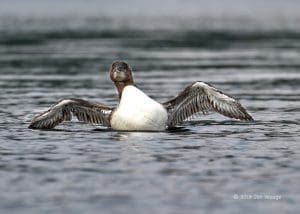
Eagle Visit
On August 7th, we were poking around in Turtle Cove after checking the loons. As luck would have it, a mature bald eagle paid a visit and we were able to get some photos to share.
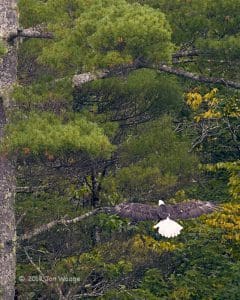
Landing in a pine. White head and tail are all that is needed to identify this great bird.

Look at the size, beak and claws and you appreciate why loons get very upset when one of these is around. Bald eagles are about 3 ft tall with a wing span of 6 to 8 ft. Females weigh up to 14 lbs, males 7-10 lbs.
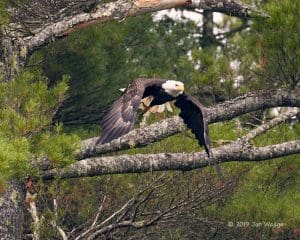
Bald Eagles gain their full adult plumage at 3 – 4 years of age, begin breeding at 4 – 6 years and live up to 30 years (very similar to Loons).

They often stay with the same mate and reuse the same nest for many years.
“One way to open your eyes is to ask yourself, ‘What if I had never seen this before? What if I knew I would never see it again?’ ” – Rachel Carson (Carson, Rachel, and Charles Pratt. The Sense of Wonder. New York: Harper & Row, 1965)
Whenever I see a Bald Eagle I thank Rachel Carson. It was her clear warning (Silent Spring, 1962) about the perils of DDT and declining bird populations that began the environmental movement to protect fellow creatures and their habitats. By 1972, DDT was banned and eagle populations were slowly beginning to recover. Although protected by law from hunting and trade since 1940, The Endangered Species Act of 1973 was another huge step for Bald Eagles and other species. Increasing from 417 pairs in 1963 to 11,040 pairs in 2007, Bald Eagles were removed from the threatened and endangered list.
Bald Eagles were on New Hampshire’s Threatened and Endangered Wildlife List until March 2017. They are now listed as “Special Concern”, and are legally protected in the state. Since the first Bald Eagle pair returned to NH in 1988, a total of 497 chicks have fledged in the state, 70 just last year.
The berry challenge is on!
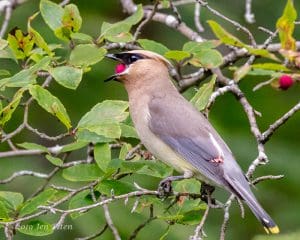
Shadbush berries are going like hotcakes. Blueberries are the next target. Be sure to get your fill soon!
Monarchs need more than Milkweed
As the new monarch adults begin to emerge and the current adults are still laying eggs, nectar is a vital resource for them. They will need a lot of fuel to fly to Mexico! If you do plant milkweed in your yard for the Monarchs, make sure you also provide lots of nectar sources for the adults.
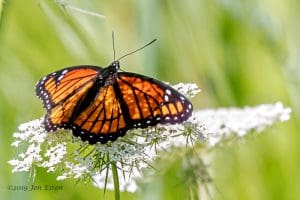
This monarch is visiting Queen Anne’s Lace (Dacus carota).
The Monarch Butterflies that will soon become adults around here will be flying to Mexico for the winter. That is where their grandmothers spent last winter. There is no butterfly here now that has ever been to the overwintering sites in Mexico, yet that is where they are going, somehow, on their own. If all goes well, some of their grandchildren will be back here next summer. How?? We know parts of how they navigate and have some guesses on how information about just where to go might be transferred across generations. Maybe one of your grandkids will figure it out.
Meanwhile, lets take another look at Queen Anne’s Lace because it is also involved in food we eat.

This widespread plant, Queen Anne’s Lace, was introduced from Europe long ago and is fully naturalized in North America.
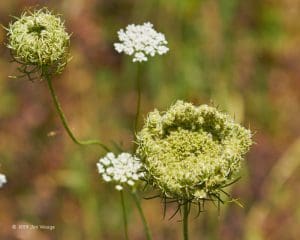
This is the seed head after the flowers are done. You can see why it is also called Birds Nest.
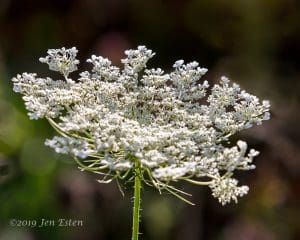
You know Dacus carota well, though you may not recognize it in nature. The Latin name is a hint. Yes, it is the same species as the carrot you eat and what carrots in your garden would look like if you let them bolt. If you were to scratch and sniff the root of Queen Anne’s Lace or even look carefully at the leaves you would smell or see that it is a carrot. BUT, do not do that unless 1) you are sure it is not Poison Hemlock which looks very similar and can grow in the same areas, and 2) you are wearing gloves (some people get a rash from handling the plant).
Photos by Jen Esten and Jon Waage
